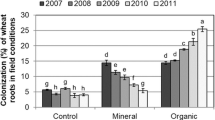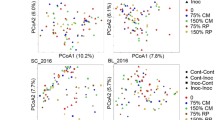Abstract
A greenhouse experiment was conducted to assess the arbuscular mycorrhizal (AM) fungi inoculum potential for Leucaena leucocephala in a range of nutrient-depleted farm soils in western Kenya. Leucaena was grown in 12 uninoculated farm soils with pH 5.0–6.7, with or without rock P and farmyard manure. Root infection, nodulation, and shoot and root weight were determined 25, 46, and 69 days after planting. Spore concentrations in the farm soils at the start of the experiment ranged from 44 to 126 live spores per 100 g dry soil with 6–10 species per soil, principally Scutellospora spp. and Acaulospora spp. Nodulation was absent or poor in all soils, indicating the need for rhizobial inoculation of species belonging to the leucaena crossinoculation group in this agrosystem. Rock-P alone increased final shoot dry weight by a factor of 1.4, manure alone by 1.8, and rock-P plus manure by 1.9, compared with no ameliorant. Root infection with AM fungi was detected in all soils 25 days after planting and increased linearly in the different farm soils to values of 33–65% 69 days after planting. Soil pH and root infection 25 days after planting accounted for much of the variation in final shoot weight among soils with no amelioront (87%). As early root infection increased from 20 to 40% at soil pH 5.0, the predicted final shoot dry weight was doubled, and the response to ameliorants was reduced by two-thirds. The growth responses to increased infection became smaller as pH increased from 5.0 to 6.5.
Similar content being viewed by others
References
Aziz T, Sylvia DM (1991) The symbiotic association between vesicular-arbuscular mycorrhizal fungi and Leucaena leucocephala. Leucaena Res Rep 12:111–118
Giller KE, Wilson KJ (1991) Nitrogen fixation in tropical cropping systems. CAB International, Wallingford
Habte M, Manjunath A (1987) Soil solution phosphorus status and mycorrhizal dependency in Leucaena leucocephala. Appl Environ Microbiol 53:797–801
ICRAF (1993) ICRAF annual report for 1992. International Centre for Research in Agroforestry, Nairobi
International Fertilizer Development Centre (1990) Minjingu phosphate rock marketing study — a marketing plan for Minjingu Phosphate Company (MIPCO), Arusha, Tanzania. IFDC, Muscle Shoals Ala
Janos DP (1988) Mycorrhiza applications in tropical forestry: Are temperate-zone approaches appropriate? In: Ng FSP (ed) Trees and mycorrhiza. Proceedings of the Asian seminar, 13–17 April 1987, Kuala Lumpur. Forest Research Institute, Kuala Lumpur, pp 133–188
Jenkins WR (1964) A rapid centrifugal-floatation technique for separating nematodes from soil. Plant Dis Rep 48:692
Koske RE, Gemma JN (1989) A modified procedure for staining roots to detect VA mycorrhizas. Mycol Res 92:486–505
Mason PA, Wilson J (1994) Harnessing symbiotic associations: Vesicular-arbuscular mycorrhizas. In: Leakey RRB, Newton AC (eds) Tropical trees: The potential for domestication and the rebuilding of forest resources. ITE Symposium No 29, ECTF Symposium No 1. Proceedings of a conference organized by the Edinburgh Centre for Tropical Forests, held at Heriot-Watt University Edinburgh on 23–28 August 1993. HMSO, London, pp 165–175
Munns DN, Mosse B (1980) Mineral nutrition of legume crops. In: Summerfield RJ, Bunting AH (eds) Advances in legume science. Royal Botanic Gardens, Richmond, pp 115–125
Nelson DW, Sommers LE (1982) Total carbon, organic carbon and organic matter. In: Page AL, Miller RH, Keeney DR (eds) Methods of soil analysis, Part 2. Am Soc Agron, Madison, Wis, pp 539–579
Ndufa JK, Ohlsson E, Shepherd KD (1992) Participatory research methods for agroforestry technology development in western Kenya. Toward a new paradigm for farming systems research/extension. Working Paper Set for the 12th Annual Farming Systems Symposium. The Association for Farming Systems Research/Extension, Michigan State University, pp 111–125
Olsen SR, Cole CV, Watanabe FS, Dean LA (1954) Estimation of available phosphorus in soils by extraction with sodium bicarbonate. USDA Circ 939, Washington DC
Parkinson JA, Allen SE (1975) A wet oxidation procedure for the determination of nitrogen and mineral nutrients in biological materials. Commun Soil Sci Plant Anal 6:1–11
Phillips JM, Hayman DS (1970) Improved procedures for clearing roots and staining parasitic and vesicular-arbuscular mycorrhizal fungi for rapid assessment of infection. Trans Br Mycol Soc 55:58–161
Schenck NC, Perez Y (1988) Manual for the identification of VA mycorrhizal fungi. International Culture Collection of VA Mycorrhizal fungi, University of Florida, Gainsville, Fla
Shepherd KD (1992) Phosphorus in agroforestry systems: New research initiatives of the International Council for Research in Agroforestry. In: Tiessen H, Frossard E (eds) Phosphorus cycles in terrestrial and aquatic ecosystems. Rogional workshop 4: Africa. Proceedings of a workshop arranged by the Scientific Committee on Problems of the Environment (SCOPE) and the United Nations Environmental Programme (UNEP) at UNEP, Nairobi, Kenya, March 18–22, 1991. Saskatchewan Institute of Pedology, University of Saskatchewan Saskatoon, pp 73–85
Shepherd KD, Ohlsson E, Okalebo JR, Ndufa JK, David S (1995) A static model of nutrient flow on mixed farms in the highlands of western Kenya to explore the possible impact of improved management. In: Powell JM, Fernandez-Rivera S, Williams TO, Renard C (eds) Livestock and sustainable nutrient cycling in mixed farming systems of sub-Sharan Africa. Vol II. Technical Papers. Proceedings of the International Conference held 22–26 November 1993, Addis Ababa, Ethiopia. International Livestock Centre for Africa, Addis Ababa, pp 523–538
Sieverding E (1991) Vesicular-arbuscular mycorrhiza management in tropical agrosystems. German Technical Cooperation (GTZ), Eschborn
Smaling EMA, Stoorvogel JJ, Windmeijer PN (1993) Calculating soil nutrient balances in Africa at different scales. II. District scale. Fert Res 35: 237–250
Soedarjo M, Habte M (1993) Vesicular-arbuscular mycorrhizal effectiveness in an acid soil amended with fresh organic matter. Plant and Soil 149:197–203
Stoorvogel JJ, Smaling EMA, Janssen BH (1993) Calculating soil nutrient balances in Africa at different scales. I. Supra-national scale. Fert Res 35:227–235
Tennant D (1975) A test of a modified line intersect method of estimating root length. J Ecol 63:995–1001
Walker C, Mise CW, McNabb HS (1982) Populations of endogonaceous fungi at two locations in Central Iowa. Can J Bot 60:2518–2529
Author information
Authors and Affiliations
Rights and permissions
About this article
Cite this article
Shepherd, K.D., Jefwa, J., Wilson, J. et al. Infection potential of farm soils as mycorrhizal inocula for Leucaena leucocephala . Biol Fert Soils 22, 16–21 (1996). https://doi.org/10.1007/BF00384427
Received:
Issue Date:
DOI: https://doi.org/10.1007/BF00384427




